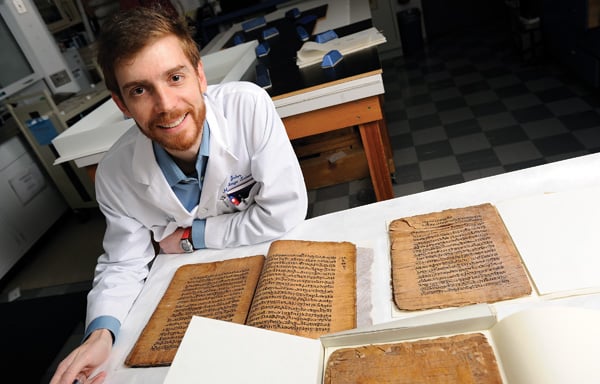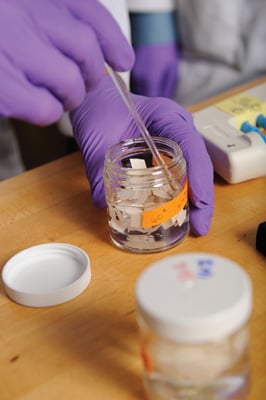
While much of engineering today is focused on high-tech solutions to forward-thinking problems, a group of collaborators at Johns Hopkins is aiming to turn back the ravages of time to preserve the past.
As pioneers in the field of book and paper conservation research, scholars at the Heritage Science for Conservation (HSC) project, a joint effort between the Sheridan Libraries and the Whiting School of Engineering’s Department of Materials Science and Engineering, are hoping to spur the establishment of similar efforts around the country.
A recent $1.1 million grant from the Andrew W. Mellon Foundation will allow the HSC to continue the groundbreaking work it began in 2009, seeking to better understand the causes of paper degradation and to develop new technologies for book, paper, and document analysis and conservation.

The HSC was founded on the principle of close collaboration among materials scientists, conservators, and industry. Working in close proximity to one another in the conservation lab is unique in the world of cultural heritage conservation, says Sonja Jordan-Mowery, associate director of the libraries’ Conservation and Preservation Department.
With pilot funding from Mellon in 2009, postdoctoral fellow John W. Baty joined the team that developed the concept of HSC. On May 1, Baty—who holds a PhD in paper science—was named assistant research professor and HSC scientist, a joint appointment at the libraries and the Whiting School. Both he and Jordan-Mowery have lectured to undergraduate and graduate students on the chemical and biological properties of paper, and have presented their research findings in articles and at numerous academic conferences.
Johns Hopkins Technology Transfer has filed provisional patent applications for three of HSC’s technologies related to paper analysis and conservation, says Baty. The first is a calibration kit to help conservators use spectrometers to analyze paper more accurately in their labs. The second is an accelerated aging vessel for the improved study of materials, and the third is a set of buffer solutions that can “set” the pH of paper at a level of the conservator’s choice and retain that level over time.
It was only about 50 years ago that American libraries began to establish preservation programs, says Jordan-Mowery, in a concerted effort to respond to the degradation of archival materials. Books, photographs, and other documents on paper deteriorate because of inherent weaknesses in the raw material, she says, as well as the effects of processing, printing withmetallic inks, and improper storage.
Conservators traditionally have focused on ways to slow this inevitable deterioration by adjusting environmental conditions, such as light, temperature, and humidity. While conservators bring both an understanding of historical processes used and an appreciation for the historical context of the artifact to inform the types of mitigation and remediation they apply to an object, she says, the contributions of materials scientists—and the development of nondestructive analytical techniques—have added a key new dimension to the way conservation research is conducted.




